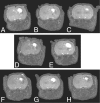Neuroprotection by the endogenous cannabinoid anandamide and arvanil against in vivo excitotoxicity in the rat: role of vanilloid receptors and lipoxygenases
- PMID: 12764100
- PMCID: PMC6741091
- DOI: 10.1523/JNEUROSCI.23-10-04127.2003
Neuroprotection by the endogenous cannabinoid anandamide and arvanil against in vivo excitotoxicity in the rat: role of vanilloid receptors and lipoxygenases
Abstract
Type 1 vanilloid receptors (VR1) have been identified recently in the brain, in which they serve as yet primarily undetermined purposes. The endocannabinoid anandamide (AEA) and some of its oxidative metabolites are ligands for VR1, and AEA has been shown to afford protection against ouabain-induced in vivo excitotoxicity, in a manner that is only in part dependent on the type 1 cannabinoid (CB1) receptor. In the present study, we assessed whether VR1 is involved in neuroprotection by AEA and by arvanil, a hydrolysis-stable AEA analog that is a ligand for both VR1 and CB1. Furthermore, we assessed the putative involvement of lipoxygenase metabolites of AEA in conveying neuroprotection. Using HPLC and gas chromatography/mass spectroscopy, we demonstrated that rat brain and blood cells converted AEA into 12-hydroxy-N-arachidoylethanolamine (12-HAEA) and 15-hydroxy-N-arachidonoylethanolamine (15-HAEA) and that this conversion was blocked by addition of the lipoxygenase inhibitor nordihydroguaiaretic acid. Using magnetic resonance imaging we show the following: (1) pretreatment with the reduced 12-lipoxygenase metabolite of AEA, 12-HAEA, attenuated cytotoxic edema formation in a CB1 receptor-independent manner in the acute phase after intracranial injection of the Na+/K+-ATPase inhibitor ouabain; (2) the reduced 15-lipoxygenase metabolite, 15-HAEA, enhanced the neuroprotective effect of AEA in the acute phase; (3) modulation of VR1, as tested using arvanil, the VR1 agonist capsaicin, and the antagonist capsazepine, leads to neuroprotective effects in this model, and arvanil is a potent neuroprotectant, acting at both CB1 and VR1; and (4) the in vivo neuroprotective effects of AEA are mediated by CB1 but not by lipoxygenase metabolites or VR1.
Figures





Similar articles
-
A structure/activity relationship study on arvanil, an endocannabinoid and vanilloid hybrid.J Pharmacol Exp Ther. 2002 Mar;300(3):984-91. doi: 10.1124/jpet.300.3.984. J Pharmacol Exp Ther. 2002. PMID: 11861807
-
Hypolocomotor effects in rats of capsaicin and two long chain capsaicin homologues.Eur J Pharmacol. 2001 May 25;420(2-3):123-31. doi: 10.1016/s0014-2999(01)01012-3. Eur J Pharmacol. 2001. PMID: 11408034
-
VR1-mediated depressor effects during high-salt intake: role of anandamide.Hypertension. 2005 Oct;46(4):986-91. doi: 10.1161/01.HYP.0000174596.95607.fd. Epub 2005 Sep 6. Hypertension. 2005. PMID: 16144988
-
New perspectives on enigmatic vanilloid receptors.Trends Neurosci. 2000 Oct;23(10):491-7. doi: 10.1016/s0166-2236(00)01630-1. Trends Neurosci. 2000. PMID: 11006466 Review.
-
Roles of transient receptor potential vanilloid subtype 1 and cannabinoid type 1 receptors in the brain: neuroprotection versus neurotoxicity.Mol Neurobiol. 2007 Jun;35(3):245-54. doi: 10.1007/s12035-007-0030-1. Mol Neurobiol. 2007. PMID: 17917113 Review.
Cited by
-
Reward enhances resilience to chronic social defeat stress in mice: Neural ECs and mGluR5 mechanism via neuroprotection in VTA and DRN.Front Psychiatry. 2023 Feb 16;14:1084367. doi: 10.3389/fpsyt.2023.1084367. eCollection 2023. Front Psychiatry. 2023. PMID: 36873216 Free PMC article.
-
Transient receptor potential vanilloid subtype 1 mediates cell death of mesencephalic dopaminergic neurons in vivo and in vitro.J Neurosci. 2005 Jan 19;25(3):662-71. doi: 10.1523/JNEUROSCI.4166-04.2005. J Neurosci. 2005. PMID: 15659603 Free PMC article.
-
Prospects for cannabinoid therapies in basal ganglia disorders.Br J Pharmacol. 2011 Aug;163(7):1365-78. doi: 10.1111/j.1476-5381.2011.01365.x. Br J Pharmacol. 2011. PMID: 21545415 Free PMC article. Review.
-
N-Arachidonoyl Dopamine: A Novel Endocannabinoid and Endovanilloid with Widespread Physiological and Pharmacological Activities.Cannabis Cannabinoid Res. 2017 Jul 1;2(1):183-196. doi: 10.1089/can.2017.0015. eCollection 2017. Cannabis Cannabinoid Res. 2017. PMID: 29082315 Free PMC article. Review.
-
Glucose concentration in culture medium affects mRNA expression of TRPV1 and CB1 receptors and changes capsaicin toxicity in PC12 cells.Iran J Basic Med Sci. 2014 Sep;17(9):673-378. Iran J Basic Med Sci. 2014. PMID: 25691944 Free PMC article.
References
-
- Adams IB, Compton DR, Martin BR ( 1998) Assessment of anandamide interaction with the cannabinoid brain receptor: SR 141716A antagonism studies in mice and autoradiographic analysis of receptor binding in rat brain. J Pharmacol Exp Ther 284: 1209–1217. - PubMed
-
- Annunziata P, Cioni C, Santonini R, Paccagnini E ( 2002) Substance P antagonist block leakage and reduces activation of cytokine-stimulated rat brain endothelium. J Neuroimmunol 131: 41–49. - PubMed
-
- Bayewitch M, Avidor-Reiss T, Levy R, Barg J, Mechoulam R, Vogel Z ( 1995) The peripheral cannabinoid receptor: adenylate cyclase inhibition and G protein coupling. FEBS Lett 375: 143–147. - PubMed
-
- Bligh E, Dyer W ( 1959) A rapid method of total lipid extraction and purification. Can J Biochem Physiol 37: 911–920. - PubMed
-
- Brooks JW, Pryce G, Bisogno T, Jaggar SI, Hankey DJ, Brown P, Bridges D, Ledent C, Bifulco M, Rice AS, Di Marzo V, Baker D ( 2002) Arvanil-induced inhibition of spasticity and persistent pain: evidence for therapeutic sites of action different from the vanilloid VR1 receptor and cannabinoid CB(1)/CB(2) receptors. Eur J Pharmacol 439: 83–92. - PubMed
Publication types
MeSH terms
Substances
LinkOut - more resources
Full Text Sources
Other Literature Sources
